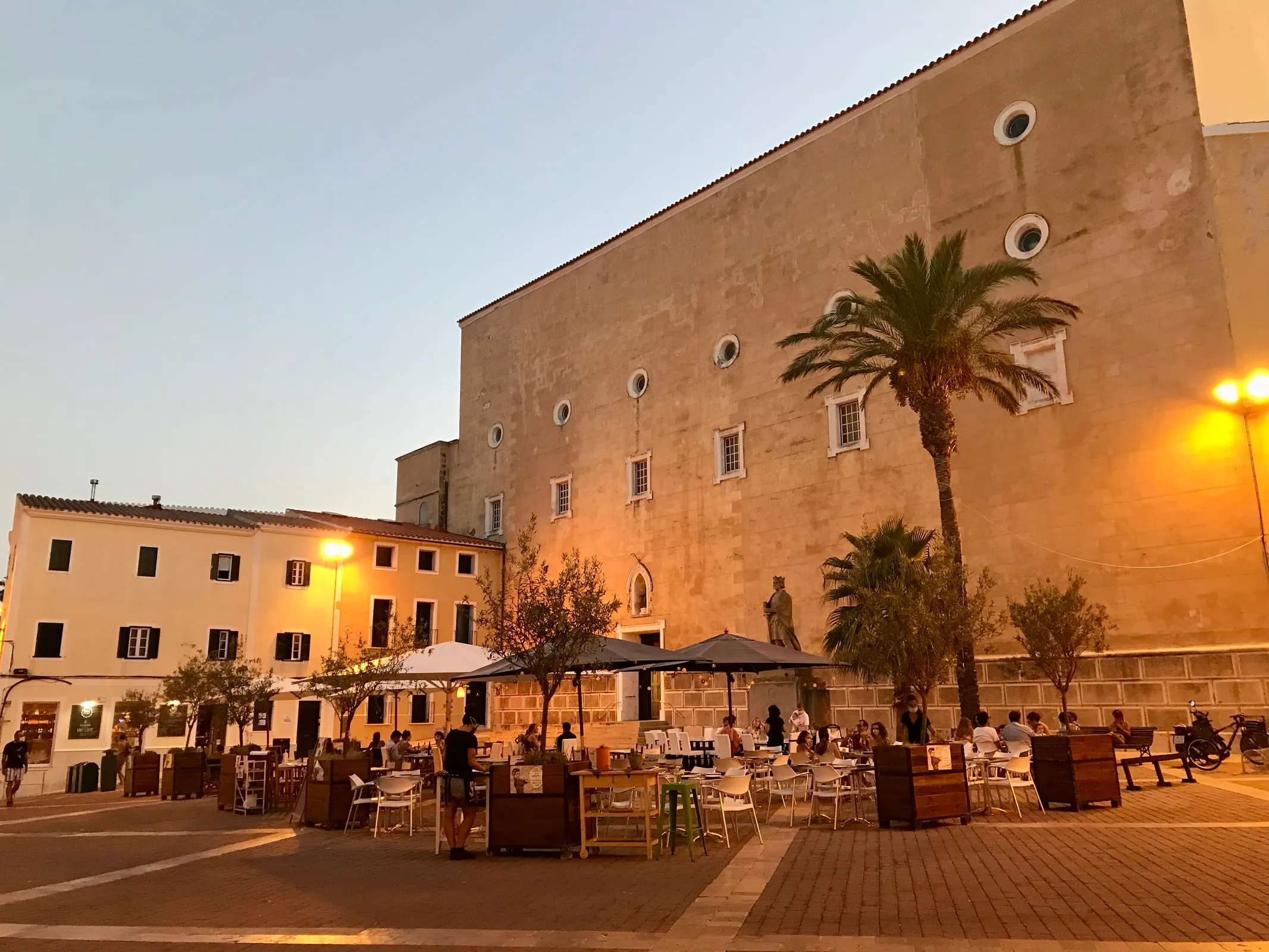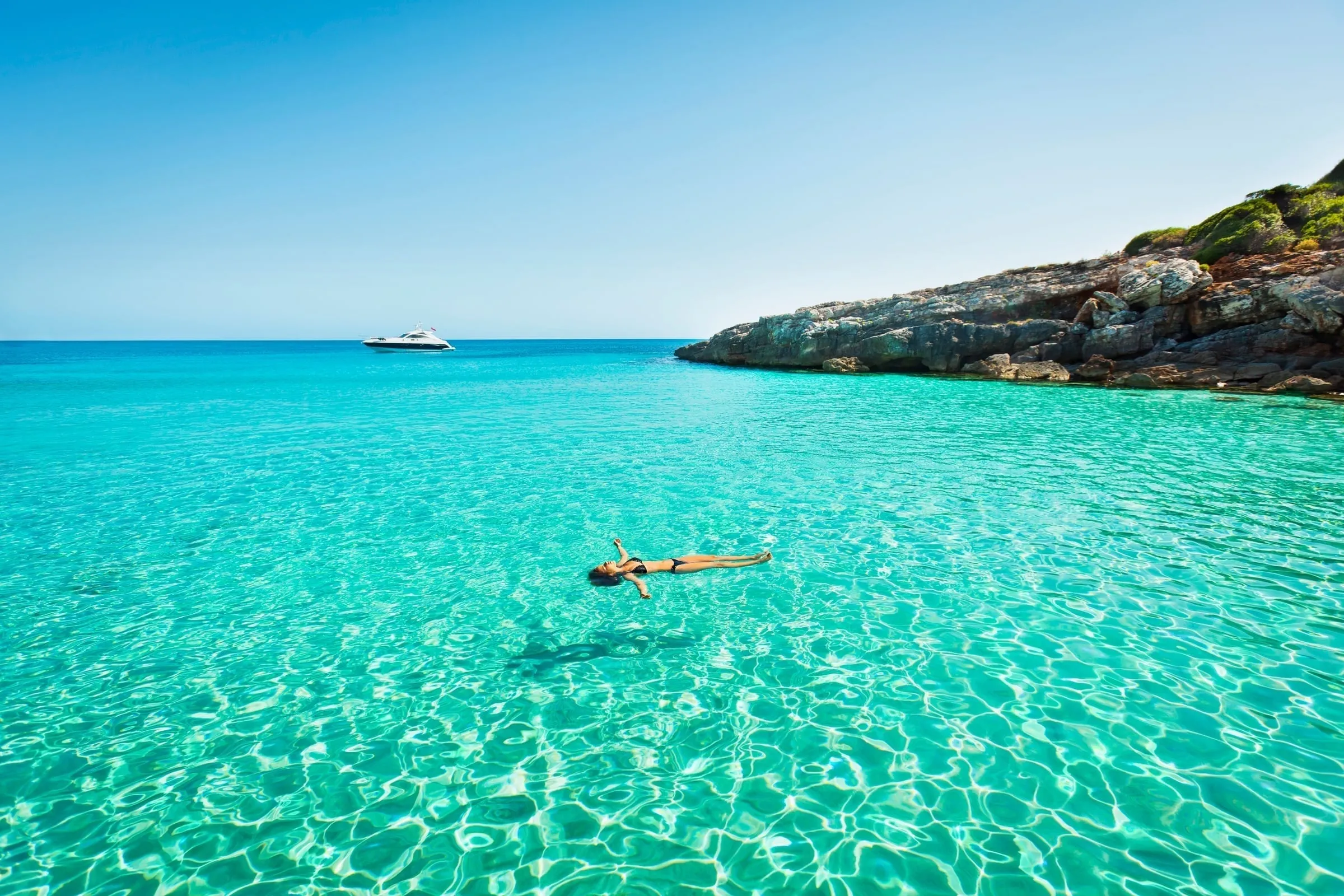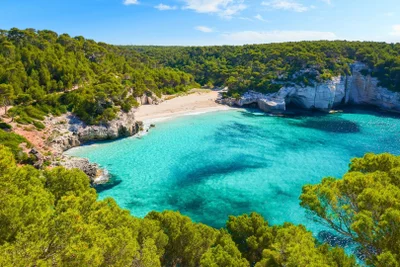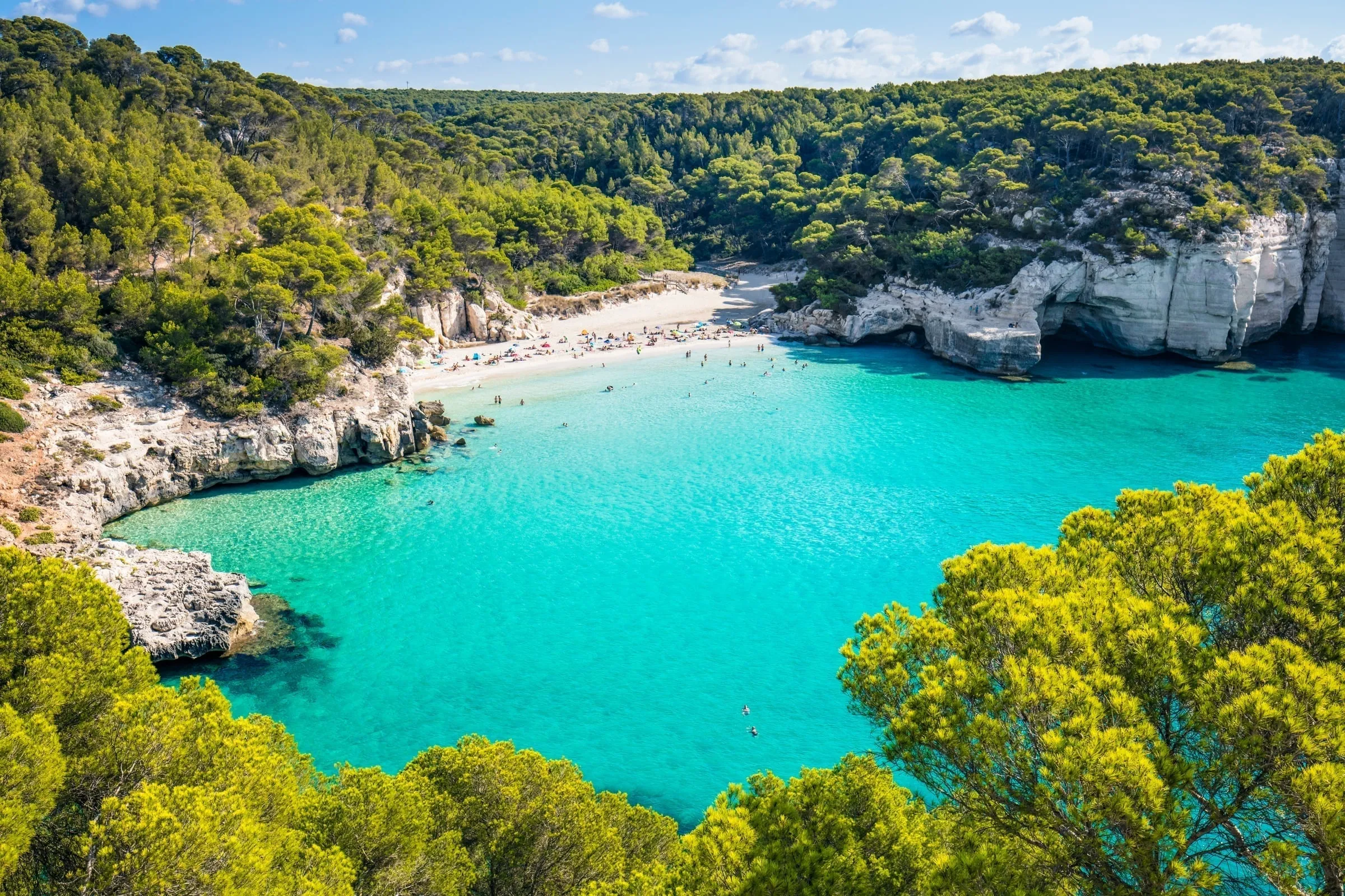The Island That Said No
At 5:23am on a Tuesday morning in June, I’m standing on the Punta Prima lighthouse watching the sun emerge from the Mediterranean. Below me, the waves crash against rocks that have been here for 400 million years – older than the Alps, older than the Atlantic Ocean. To my left, a lone runner follows the Camí de Cavalls, the ancient path that has circled this island since the 14th century. To my right, absolutely nothing. No hotels. No beach bars. No development. Just limestone cliffs dropping into water so clear I can see the shadow of a ray gliding across the sandy bottom 20 meters below.
This is Menorca in 2025: the Balearic island that looked at what happened to its neighbors and decided to take a different path.
While Mallorca processes 18.7 million tourists annually and Ibiza has become a global brand worth billions, Menorca caps its visitors at 1.4 million. While its sisters build and expand, Menorca designated 43% of its territory as protected natural areas. When UNESCO offered Biosphere Reserve status in 1993, Menorca didn’t just accept – it wrote the rules into law. No buildings over two stories outside towns. No new coastal development. No mass tourism infrastructure. Ever.
The Price of Saying No
“We could be rich,” Marina Pons tells me over coffee at the Mercat del Claustre in Mahón. She’s a marine biologist who returned to Menorca after studying in Barcelona, part of a new generation choosing preservation over profit. “Every summer, developers come with briefcases full of plans. Five-star resorts, golf courses, marinas. We say no. Always no.”
The numbers tell the story: Menorca receives 13 times fewer tourists than Mallorca despite being only 30% smaller. The average hotel room costs €110 in July (versus €280 in Ibiza). The island has exactly zero high-rise hotels, zero golf courses, and zero plans to change that. The economy grows slower. Young people still leave for better jobs. But the island remains intact.

Plaza in Mahón’s old town: Where locals gather for morning coffee before the tourists discover the day.
What UNESCO Biosphere Actually Means
Let me translate what “Biosphere Reserve” means in practice, because the tourist board won’t tell you the hard truths:
- Beach access: Many of Menorca’s best beaches require 20-60 minute walks through private land (tolerated, not guaranteed)
- Development freeze: That empty coastline? It’s staying empty. No new hotels, apartments, or restaurants outside existing zones
- Agricultural priority: Those stone walls (
parets seques) dividing fields? Protected. The cows have right of way on rural roads - Species protection: The Audouin’s gull, Hermann’s tortoise, and 28 endemic plant species take precedence over tourist convenience
- Dark sky preservation: Limited street lighting to protect nocturnal wildlife (bring a torch)
“Biosphere Reserve isn’t a marketing slogan here,” explains Dr. Josep Suárez from the Island Council’s environment department. “It’s a legally binding commitment. Every planning decision, every business license, every new trail must pass environmental review.”
When to Visit: The Rhythm of a Reserved Island
The New Reality of Seasons
Menorca doesn’t have a tourist season – it has a survival season. From November to March, 60% of restaurants close. Not “reduced hours” – padlocked shut. The island’s 95,000 residents reclaim their home, speaking Menorquí (the local Catalan dialect) in bars that spent summer serving gin-tonics to Germans.
“We hibernate,” laughs Toni Camps, who runs a beach bar in Cala Galdana from May to October and spends winters fishing. “By November, we’re exhausted. The island needs to rest. We need to rest.”
When to Visit
Jan
Island in hibernation
Feb
Almond blossoms arrive
Mar
Locals emerge
Apr
Easter awakening
May
Perfect balance
★ BestJun
Ideal conditions
★ BestJul
Peak season
Aug
Maximum capacity
Sep
Second spring
★ BestOct
Last warm days
★ BestNov
Island closes
Dec
Deep winter
The Tramontana Truth
Nobody mentions the wind. The Tramontana blows from the north 120 days per year, gusting up to 100km/h. It sculpts the vegetation, shapes the architecture (notice how all traditional houses face south), and determines which beaches are swimmable on any given day.
“Menorca has two coasts,” explains Pep, a fisherman in Fornells. “When Tramontana blows, forget the north beaches – waves like mountains. Go south. When it’s calm, the north coast is paradise. The south gets boring.”
The Two-Coast Strategy
- North wind days: Cala Galdana, Cala’n Porter, Son Bou (south coast)
- Calm days: Cala Pregonda, Cavalleria, Cala Pilar (north coast)
- Check daily: windy.com or ask any bar owner
Getting Here: The Accessibility Paradox
MAH Airport Reality
Mahón Airport (MAH) is what Palma was 30 years ago. One terminal. Four baggage belts. A single cafe that closes at 8pm. In July 2024, it handled 580,000 passengers – what Palma processes in four days.
Direct flights exist (May-October only):
- UK: London, Manchester, Birmingham (2.5 hours)
- Germany: Frankfurt, Munich, Berlin (2.5 hours)
- France: Paris, Lyon (2 hours)
- Spain: Madrid, Barcelona (1 hour)
November-April reality: Connect through Barcelona or Palma. The island essentially closes to international tourism.
Getting to Menorca
As of August 2025The Ferry Alternative
The overnight Trasmediterránea ferry from Barcelona docks at 5:30am in Mahón harbor. You wake up sailing past the Illa del Rei, where a military hospital has stood since 1287. The morning light turns the harbor’s Georgian facades gold. It’s how the British Navy arrived in 1708, and honestly, the best way to understand why they stayed 100 years.
Moving Around: Embracing the Limitations
The Truth About Public Transport
The TIB bus network connects Mahón to Ciutadella (Line 01, €6.80, one hour) and serves major beaches in summer. That’s it. No night buses. No Sunday service to most beaches. No connections between northern beaches.
“We had a choice,” says Maria from the transport department. “More buses means wider roads. Wider roads means destroying stone walls. The walls are 300 years old. The tourists are here for three days.”
The Bicycle Revolution
Since 2020, Menorca has quietly become a cycling paradise. The entire Camí de Cavalls (185km) is now navigable by mountain bike. Bike rental shops have tripled. Hotels offer free bikes. The island is small enough (48km long) that you can cycle anywhere in a day.
Realistic cycling times (from Mahón):
- Cala Mesquida: 45 minutes (mostly flat)
- Es Grau: 20 minutes (one small hill)
- Fornells: 1.5 hours (rolling hills)
- Ciutadella: 2.5 hours (for the committed)
Transport Reality Check
As of August 2025Where to Stay: The Great Divide
Mahón: The Working Capital
Population: 29,000 • Hotels: 12 • Character: Authentic
Mahón feels like a real city because it is one. Government workers drink coffee at Baixamar. The Sant Antoni market sells vegetables, not souvenirs. The Teatre Principal (1829) hosts actual opera, not flamenco for tourists.
“Mahón doesn’t pretend,” says Laura Bermejo, who runs the boutique Hotel Casa Albertí. “We have the world’s second-deepest natural harbor. The British Navy was here for a century. The architecture is Georgian. The gin is excellent. That’s enough.”
Ciutadella: The Beautiful Contradiction
Population: 30,000 • Hotels: 18 • Character: Aristocratic
Ciutadella was Menorca’s capital until the British moved it to Mahón in 1722 (better harbor for their fleet). The aristocracy never forgave them. Today, their palaces line narrow streets that flood dramatically whenever it rains (the medieval drainage can’t cope). The port is postcard-perfect. The old town is stunning. The prices reflect it.

Swimming in Menorca’s crystal-clear waters: The island’s pristine coastline offers some of the Mediterranean’s most beautiful beaches.
Mahón & Es Castell
The working east: Deep harbor, British architecture, actual residents. Hotels cluster around the port. Es Castell (10 minutes away) offers better value and stunning sunrise views from the easternmost point in Spain.
 BOUTIQUE
BOUTIQUE Casa Albertí
Advantages
- Owner Laura shares island secrets
- Exceptional breakfast
- Central location
Considerations
- Books up fast
- No pool
 TRADITIONAL
TRADITIONAL Hotel Port Mahón
Advantages
- Reasonable prices
- Walking distance to center
- Parking available
Considerations
- Dated rooms
- Tour groups
 BOUTIQUE
BOUTIQUE Jardí de Ses Bruixes
Advantages
- Gorgeous grounds
- Intimate size
- Excellent restaurant
Considerations
- 15-min walk to harbor
- Expensive
 RESORT
RESORT Barceló Hamilton
Advantages
- Family-friendly
- Sunrise views
- Quiet area
Considerations
- Package tourist vibe
- 10min from Mahón
Ciutadella
The aristocratic west: Medieval streets, sunset harbor, higher prices. The old town oozes charm but floods in heavy rain. The port is beautiful but noisy until 2am in summer.
 LUXURY
LUXURY Faustino Gran
Advantages
- Stunning restoration
- Prime location
- Impeccable service
Considerations
- Very expensive
- Can feel formal
 BOUTIQUE
BOUTIQUE Hotel Tres Sants
Advantages
- Charming atmosphere
- Reasonable luxury
- Quiet street
Considerations
- Small rooms
- No pool
 BUDGET
BUDGET Hostal Sa Prensa
Advantages
- Actually affordable
- Authentic feel
- Helpful owners
Considerations
- Very basic
- Shared bathrooms available
 RURAL
RURAL Agroturismo Biniatram
Advantages
- Total peace
- Gorgeous pool
- Organic breakfast
Considerations
- Need car
- Expensive for rural
The Beaches: Understanding the System
The Access Hierarchy
Menorca’s beaches operate on an unspoken caste system:
Tier 1: The Parking Beaches (Son Bou, Cala Galdana, Arenal d’en Castell)
- Parking spaces, restaurants, lifeguards
- Accessible by bus in summer
- Packed by 10am July-August
- Perfect for families with young kids
Tier 2: The Walking Beaches (Cala Macarella, Cala Mitjana, Cala Turqueta)
- 15-20 minute walks from parking
- Some have beach bars
- Crowded but bearable
- The Instagram favorites
Tier 3: The Commitment Beaches (Cala Pilar, Cala Pregonda, Cala Escorxada)
- 30-60 minute hikes required
- No facilities whatsoever
- Often empty even in August
- The real Menorca
Tier 4: The Boat-Only Beaches (Cala Trebalúger, Cala Fustam, Cala’n Caldés)
- Accessible only by boat or 2+ hour hikes
- Completely undeveloped
- Maybe 10 people all day
- Worth the effort
The North vs South Divide
The island’s geology creates two completely different coastlines:
North Coast: Red sandstone cliffs, golden sand, wild and exposed
- Best beaches: Cavalleria, Pregonda, Pilar
- Character: Dramatic, windswept, often wavy
- Access: Difficult, most require hiking
- Crowds: Minimal due to access
South Coast: White limestone cliffs, white sand, turquoise coves
- Best beaches: Macarella, Turqueta, Mitjana
- Character: Caribbean-like, usually calm
- Access: Easier, some have parking nearby
- Crowds: Heavy in summer

Cala Mitjana from above: One of Menorca’s most beautiful beaches, best visited early morning or late afternoon.
Cala Pregonda
moderate accessFacilities
Important Notes
30-minute hike through private farmland
No shade, facilities, or water
Red sand stains white clothing
Often wavy when north wind blows
Cala Trebalúger
hard accessFacilities
Important Notes
2.5-hour hike from Cala Galdana
Or 20-minute kayak from Cala Galdana
River meets sea creating unique ecosystem
Bring everything - absolutely no facilities
The Camí de Cavalls: The 185km Question
What It Really Is
The Camí de Cavalls (Path of Horses) has circled Menorca since the 14th century, built to connect defensive towers against pirate raids. Abandoned for decades, it was reclaimed through legal battles, restored with EU funds, and opened as a public path in 2010. Now it’s marketed as “Menorca’s great hiking trail.”
Here’s what they don’t tell you: It’s 185km of wildly varying difficulty. Some sections are pleasant coastal strolls. Others are knee-destroying boulder fields. The signage is inconsistent. Water sources are rare. And in summer, the exposed sections become furnaces.
“The Camí is not a walk,” says Joan Mora, who’s hiked it twelve times. “It’s a commitment. Beautiful, yes. But also brutal.”
Camí de Cavalls Complete Circuit
challenging- 185km coastal circuit
- 20 stages of varying difficulty
- Every beach on the island
- 1,574 archaeological sites passed
The Realistic Approach
Instead of the full circuit, cherry-pick the best sections:
Stage 5: Cala Galdana to Santo Tomás (10.8km, 3 hours)
- Spectacular cliff views
- Pass five pristine beaches
- Mostly flat and shaded
- Beach bars at both ends
Stage 10: Arenal to Favàritx (13.5km, 4 hours)
- Lunar landscape at Favàritx
- Wild, remote feeling
- Moderate difficulty
- Bring water (no sources)
Stage 13: Cala Morell to Algaiarens (9.5km, 3 hours)
- Dramatic north coast
- Two perfect beaches at the end
- Rocky but manageable
- Best in calm weather
The Talayotic Mystery: Europe’s Forgotten Civilization
3,000 Years of Stone
Menorca has more prehistoric monuments per square kilometer than anywhere else in the Mediterranean. The Talayotic culture (1400-123 BC) left behind 1,574 documented sites: massive stone towers (talayots), T-shaped altars (taulas), and burial chambers (navetas). In 2023, UNESCO recognized 32 of these sites as World Heritage.
What makes them remarkable isn’t just their age or number – it’s their mystery. We don’t know what the taulas were for. We don’t understand the talayots’ purpose. The culture left no writing, no art, just stones arranged with purpose we can’t decode.
“Every farmer here has a talayot in their field,” explains archaeologist Dr. Cristina Rihuete. “They plow around them, graze sheep between them, treat them like big rocks. But these rocks are older than Rome, older than Athens. This whole island is an archaeological site.”
The Essential Sites
Torre d’en Galmés (Near Alaior)
- Largest settlement: 6 hectares, 3 talayots
- Best preserved taula
- Free entry with guided tours
- Visit at sunset when stones glow red
Naveta d’Es Tudons (Between Mahón and Ciutadella)
- Oldest roofed building in Europe (1400 BC)
- Held 100 bodies over 600 years
- €2 entry, often empty
- Shaped like an overturned boat
Trepucó (Outside Mahón)
- Massive 5-meter taula
- Urban setting (surrounded by houses)
- Free access
- Locals do yoga here at sunrise
Where Locals Actually Eat
The Death and Rebirth of Menorcan Cuisine
For decades, Menorcan food meant caldereta de langosta (€65 lobster stew) for tourists and leftovers for locals. But something shifted around 2018. Young chefs started returning from Barcelona and London. They discovered their grandmothers’ recipes were actually interesting. They realized Mahón cheese and Menorcan gin weren’t just airport souvenirs.
“We forgot we had a cuisine,” says chef Sílvia Anglada at Toc de Groc in Ciutadella. “Not Spanish, not Catalan – Menorcan. British influences from the occupation. French techniques from brief Napoleonic rule. Arab spices from before that. All mixed with whatever grows here.”
Ca n'Aguedet
Traditional MenorcanSignature dishes
Thursday is perol day – a massive clay pot of rice and vegetables. €12, feeds two, vanishes by 2pm.
Toc de Groc
Modern MenorcanSignature dishes
Chef Sílvia trained at Noma. She applies Nordic techniques to Menorcan ingredients. The results are revelatory.
Bar Imperi
Workers' cafeSignature dishes
Unchanged since 1958. The bocadillos are massive. The coffee is strong. The regulars will stare. Perfect.
The Realities Nobody Mentions
The Mosquito Situation
Menorca has mosquitos. Lots of them. The wetlands that make it a Biosphere Reserve also breed billions of mosquitos May through October. They’re particularly vicious at Es Grau lagoon and around Albufera. Hotels don’t mention this. Bring serious repellent.
The Parking Nightmare
Beach parking is a blood sport. Cala Macarella’s 40 spaces fill by 9am in summer. People park on roads, in fields, anywhere. Police ticket aggressively (€200 fines). The solution? Arrive at 7am, leave by 5pm, or take a boat.
The Water Temperature Truth
The Med here is colder than you expect. Even in August, it rarely exceeds 26°C. In May, it’s a “refreshing” 18°C. The north coast is always 1-2 degrees colder. Locals don’t swim until June.
The Language Reality
Menorquí (the local Catalan dialect) is the first language. Spanish second. English distant third. In Mahón and Ciutadella, you’ll manage. In rural areas, pointing and smiling is your friend. Learn “bon dia” (good morning) and “gràcies” (thanks) – effort matters here.
How Many Days Do You Really Need?
The Minimum Viable Menorca (4-5 days)
Day 1-2: Pick a base (Mahón or Ciutadella), explore the town Day 3: South coast beach hopping Day 4: North coast adventure Day 5: Camí de Cavalls section or Talayotic sites
The Comfortable Week
Allows you to see both coasts properly, hike a serious Camí section, explore both main towns, and have a lazy beach day without guilt.
The Ideal (10+ days)
This is when Menorca reveals itself. You stop chasing sights. You find your beach. You recognize faces at the market. You understand why people come for a week and stay for a lifetime.
The Future Question: Can This Last?
The Pressure Building
In 2024, Menorca saw a 12% increase in visitors. Property prices rose 18%. Young locals can’t afford homes. The summer water supply is stressed. The very things that make Menorca special – the limitations, the protections, the empty spaces – are under pressure.
“Every year they ask us to allow just one more hotel, just one more development,” says Marina, the marine biologist. “Every year we say no. But every year it gets harder.”
If You Come (And You Should, But Carefully)
Come in May or October. Rent a bike sometimes instead of always driving. Eat where Spanish is the only language on the menu. Take your trash from the beaches. Don’t post geotagged photos of secret spots. Stay in locally-owned hotels. Buy from the markets, not the supermarkets.
Most importantly, understand what you’re seeing: An island that chose preservation over profit, community over commerce, tomorrow over today. In the Mediterranean of 2025, that’s rarer than any beach.
The Last Word
Standing on that Punta Prima lighthouse at sunrise, watching the runner on the Camí de Cavalls disappear around the headland, I understand why Menorca matters. Not because it’s paradise – plenty of places have beautiful beaches and clear water. But because it’s proof that another way is possible.
In a Mediterranean where every meter of coastline is monetized, where every beach has a price, where every view is developed, Menorca stands apart. Not untouched – humans have been here for 4,000 years. But undeveloped by choice. Protected by decision. Preserved by the radical act of saying no.
The question isn’t whether you should visit Menorca. It’s whether Menorca should let you. Come with respect, come with understanding, come knowing that you’re visiting something precious and finite. Because in 10 years, 20 years, this might be the only place in the Mediterranean that still looks like the Mediterranean.
Sofia Nadal divides her time between Menorca and Barcelona, documenting the islands that refuse to disappear. She’s walked the entire Camí de Cavalls three times and still discovers new beaches every summer.
Essential Menorca 2025 Questions
01 Is Menorca really that much quieter than Mallorca?
Dramatically so. Menorca receives 1.4 million annual visitors versus Mallorca's 18.7 million. In practical terms: you can find empty beaches in August, restaurants where locals eat, and entire coastal sections without development. The difference is legally protected, not accidental.
02 Do I really need a rental car?
Yes, unless you're staying at an all-inclusive resort. Buses serve only major routes and stop early. Many of the best beaches require driving plus walking. Taxis are expensive and scarce. Book your car 3-4 months ahead for summer or pay triple.
03 What's this about beaches requiring long walks?
About 60% of Menorca's best beaches have no direct car access. Expect 15-60 minute walks through private farmland (traditionally tolerated). Cala Macarella: 20 minutes. Cala Pregonda: 30 minutes. Cala Pilar: 40 minutes. This is by design, not oversight.
04 Is the water really that turquoise?
On the south coast, yes – caused by white sand and limestone seabed. The north coast has golden/red sand creating different colors. Best turquoise: Cala Turqueta, Macarella, Mitjana. No filters needed.
05 What's the deal with everything closing in winter?
From November to March, 60% of restaurants and hotels close completely. Not reduced hours – shuttered. The island essentially hibernates. Locals need the rest after summer. Plan accordingly or embrace eating at the same three restaurants.
06 Can you really walk around the entire island?
The Camí de Cavalls circles all 185km of coastline. It's beautiful but brutal – rocky, exposed, poorly marked in places. Most people do day sections. Full circuit takes 8-10 days. Bring serious boots and more water than you think.
07 Is Menorca child-friendly?
Extremely. Shallow, calm beaches on the south coast. Family-oriented culture. Safe environment. Kids eat free at many restaurants. Only challenges: long walks to some beaches and limited activities beyond beach/pool.
08 What about mosquitos?
Yes, they're bad May-October, especially near wetlands (Es Grau, S'Albufera). Hotels rarely mention this. Bring proper DEET-based repellent. Worst at dusk. Some people react badly to bites. Consider antihistamines.
09 Is the UNESCO Biosphere thing just marketing?
No. It's legally binding. 43% of land protected. No coastal development. Building height restrictions. Dark sky preservation. Agricultural subsidies. This shapes everything from beach access to restaurant hours. It's why Menorca looks like Menorca.
10 Should I stay in Mahón or Ciutadella?
Mahón: more authentic, better restaurants, working harbor, central location. Ciutadella: more beautiful, medieval charm, tourist-oriented, better sunsets. For beaches: neither – stay in between. For culture: either works.
Explore More of Menorca
Sources & References
- Consell Insular de Menorca, Tourism Statistics 2024
- UNESCO Biosphere Reserve Reports, Menorca 1993-2025
- Institut Menorquí d’Estudis, Talayotic Culture Studies
- OBSAM (Environmental Observatory), Sustainability Reports 2024
- Personal fieldwork and interviews, May-October 2024
- Camí de Cavalls GPS tracking and timing data
